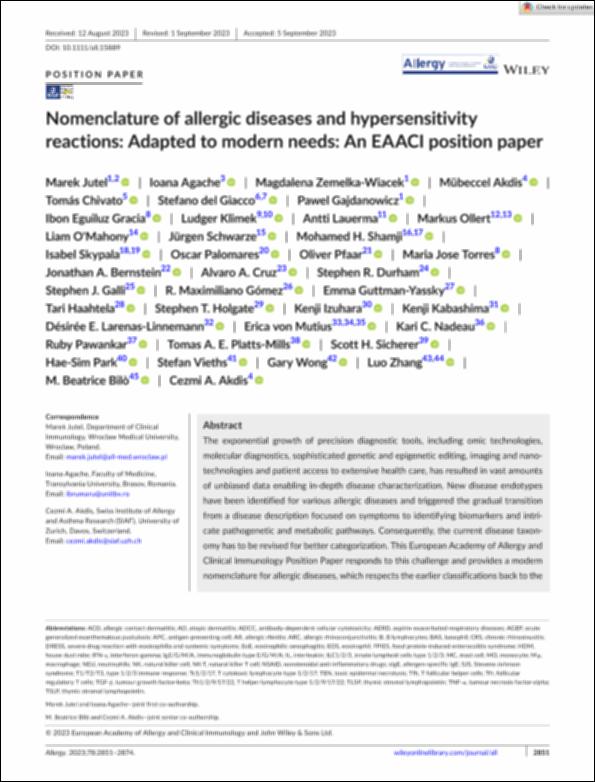Por favor, use este identificador para citar o enlazar este ítem:
http://hdl.handle.net/10637/15197Nomenclature of allergic diseases and hypersensitivity reactions: Adapted to modern needs: An EAACI position paper

Ver/Abrir:
Nomenclature_Jutel_et_al_Allergy_2023.pdf
27,36 MB
Adobe PDF
Ver/Abrir:
Correction_Nomenclature_2023.pdf
239,7 kB
Adobe PDF
| Título : | Nomenclature of allergic diseases and hypersensitivity reactions: Adapted to modern needs: An EAACI position paper |
| Autor : | Jutel, Marek Agache, Ioana Wiacek, Magdalena Zemelka Akdis, Mubeccel Chivato Pérez, Tomás Giacco, Stefano del Gajdanowicz, Pawel Eguiluz-Gracia, Ibon Klimek, Ludger Lauerma, Antti Ollert, Markus O'Mahony, Liam Schwarze, Jürgen Shamji, Mohamed Skypala, Isabel Palomares, Oscar Pfaar, Oliver Torres, María José Bernstein, Jonathan A. Cruz, Alvaro A. Durham, Stephen R. Galli, Stephen J. Gómez, R. Maximiliano Guttman-Yassky, Emma Haahtela, Tari Holgate, Stephen T. Izuhara, Kenji Kabashima, Kenji Larenas-Linnemann, Désirée E. Mutius, Erica von Nadeau, Kari C. Pawankar, Ruby Platts-Mills, Tomas A. E. Sicherer, Scott H. Park, Hae-Sim Vieths, Stefan Wong, Gary Zhang, Luo Bilò, M. Beatrice Akdis, Cezmi A. |
| Materias: | Allergic diseases; EAACI position paper; Hypersensitivity; Nomenclature; Pathophysiology; Mechanism |
| Editorial : | Wiley |
| Citación : | Jutel M, Agache I, Zemelka-Wiacek M, et al. Nomenclature of allergic diseases and hypersensitivity reactions: Adapted to modern needs: An EAACI position paper. Allergy. 2023;78:2851-2874. doi:10.1111/all.15889 |
| Resumen : | The exponential growth of precision diagnostic tools, including omic technologies, molecular diagnostics, sophisticated genetic and epigenetic editing, imaging and nanotechnologies and patient access to extensive health care, has resulted in vast amounts of unbiased data enabling in-depth disease characterization. New disease endotypes have been identified for various allergic diseases and triggered the gradual transition from a disease description focused on symptoms to identifying biomarkers and intricate pathogenetic and metabolic pathways. Consequently, the current disease taxonomy has to be revised for better categorization. This European Academy of Allergy and Clinical Immunology Position Paper responds to this challenge and provides a modern nomenclature for allergic diseases, which respects the earlier classifications back to the early 20th century. Hypersensitivity reactions originally described by Gell and Coombs have been extended into nine different types comprising antibody- (I-III), cell-mediated (IVa-c), tissue-driven mechanisms (V-VI) and direct response to chemicals (VII). Types I-III are linked to classical and newly described clinical conditions. Type IVa-c are specified and detailed according to the current understanding of T1, T2 and T3 responses. Types V-VI involve epithelial barrier defects and metabolic-induced immune dysregulation, while direct cellular and inflammatory responses to chemicals are covered in type VII. It is notable that several combinations of mixed types may appear in the clinical setting. The clinical relevance of the current approach for allergy practice will be conferred in another article that will follow this year, aiming at showing the relevance in clinical practice where various endotypes can overlap and evolve over the lifetime. |
| Descripción : | (2024), Correction to: Nomenclature of allergic diseases and hypersensitivity reactions: Adapted to modern needs: An EAACI position paper. Allergy, 79: 269-273. https://doi.org/10.1111/all.15983 |
| URI : | http://hdl.handle.net/10637/15197 |
| Derechos: | http://creativecommons.org/licenses/by-nc-nd/4.0/deed.es |
| ISSN : | 1398-9995 |
| Fecha de publicación : | 2023 |
| Centro : | Universidad San Pablo-CEU |
| Aparece en las colecciones: | Medicina |
Los ítems de DSpace están protegidos por copyright, con todos los derechos reservados, a menos que se indique lo contrario.

